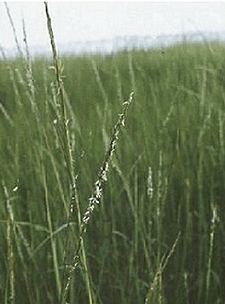Wildlife - Species

Smooth Cordgrass (Spartina alterniflora)
Description
Smooth cordgrass belongs to the grass family (Poaceae) and is a perennial wetland grass that dominates tidal salt marshes of the south. Each plant produces a tough rhizome (roots) system. The maximum height of the plants varies greatly, ranging from 20-150 cm (8-60 in) tall, and the stems are erect. Leaf blades are 4-15 mm wide, and the margins are smooth to somewhat scabrid.
Preferred Habitat and Biology
Smooth cordgrass is found from Newfoundland to Florida and west to Texas. The plant forms colonies in tidal salt marshes. In South Carolina, smooth cordgrass is found along all major estuarine waterways. The species dominates the regularly flooded marsh ("low marsh") and is a common species in the irregularly flooded marsh ("high marsh").
Existing populations of smooth cordgrass are maintained through asexual reproduction (reproducing vegetatively by means of rhizomes), and new sites are established by sexual reproduction. Smooth cordgrass produces flowers during the fall (October and November), and the seeds germinate during the following spring (March). The seeds are never dormant, but salt water will slow down the development. Smooth cordgrass seedlings grow about 20 cm (8 in), and produce flowers during their first growing season. In South Carolina, aerial growth of smooth cordgrass starts in March and ends in November, but the roots and rhizomes grow year- round. Maximum monthly growth rate occurs most commonly during July or August.
Soil salinity is a proximate determinant of inter-annual variation in primary production. Growth is negatively correlated with soil salinity-growth rate slows with increasing salinity. Highest growth rate occurs at salinities of 20 ppt or less, and the upper limit for salt tolerance is 60 ppt. Marshes with soil salinities above 75 ppt do not tend to have stands of smooth cordgrass. Height of smooth cordgrass is also inversely related to soil salinity levels. Along the creek and river banks where soil salinity level is lowest, smooth cordgrass reaches a maximum height of three meters. As the soil salinity increases with distance from the river bank, the average height of the species decreases from one meter on the levee to less than 20 inches tall at the upper reaches salt marsh where the soil salinity level is highest. Other factors that influence the growth of smooth cordgrass include soil aeration, nutrient availability, and hydroperiod.
Species Significance
Smooth cordgrass is an important food source for many endemic and migratory birds. The seeds are eaten by marshbirds, songbirds, sharp-tailed sparrows and several species of migratory waterfowl. Geese that winter along the coast are known to eat the rootstocks. Cordgrass also provides nursery and protective habitat for many aquatic species, especially juvenile crustaceans and fishes.
References
Godfrey, R.K. and J.W. Wooten. 1981. Aquatic and wetland plants of southeastern United States: Dicotyledons. The University of Georgia Press, Athens, GA.
Martin, A.C., H.S. Zim, and A.L. Nelson. 1951. American wildlife and plants: A guide to wildlife food habits. Dover Publications Inc., New York, NY.
Morris, J.T. and B. Haskin. 1990. A 5-yr record of aerial primary production and stand characteristics of Spartina alterniflora. Ecology 71(6):2209-2217.
Waisel, Y. 1972. Biology of halophytes. In: T.T. Kozlowski (ed.). Physiological ecology, a series of monographs, texts, and treatises. Academic Press, New York, NY.
Woodhouse, W.W., Jr., E.D. Seneca, and S.W. Broome. 1974. Propagation of Spartina alterniflora for substrate stabilization and salt marsh development. Technical Memorandum No. 46. U.S. Army Corps of Engineers, Coastal Engineering Research Center. Fort Belvoir, VA.
